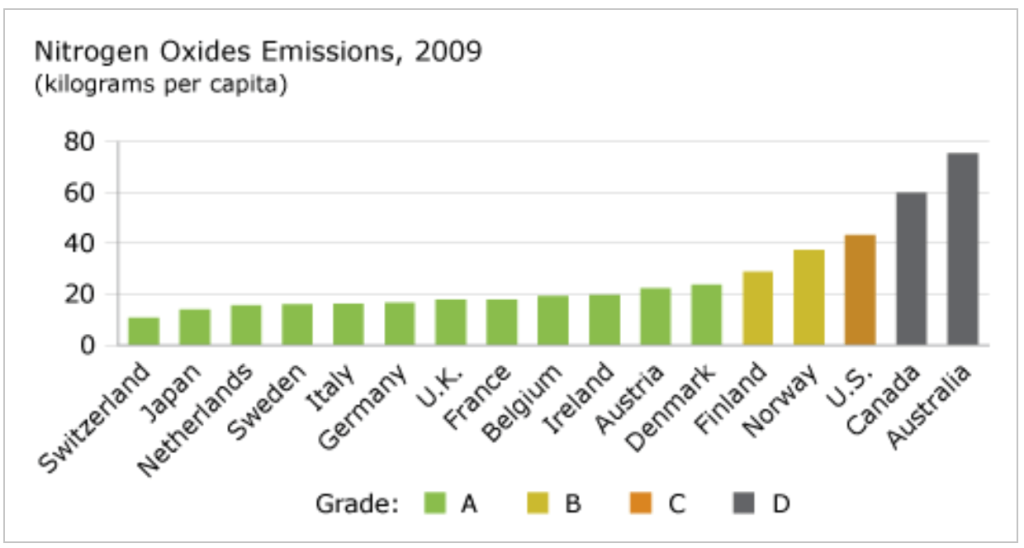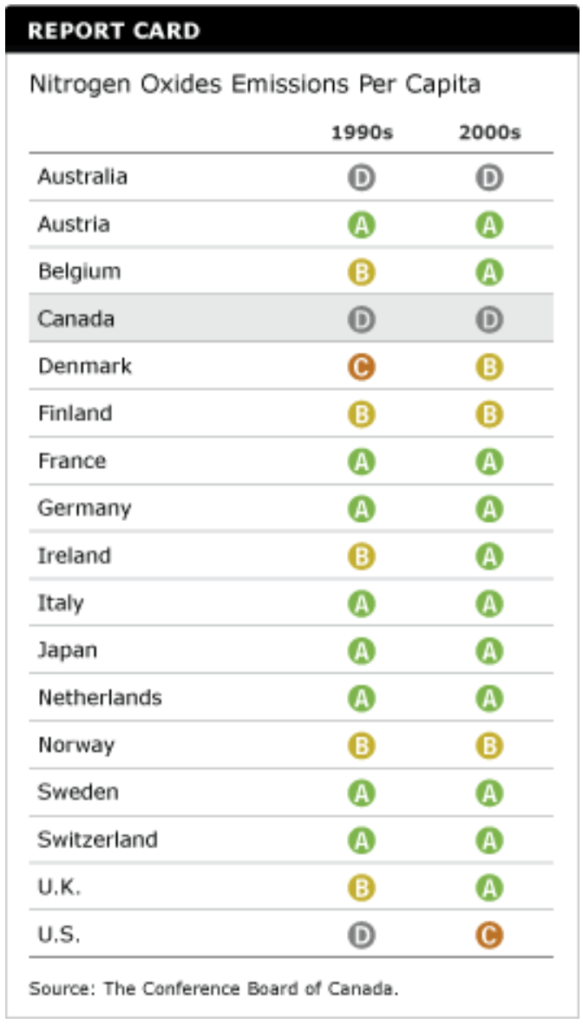Nitrogen Oxides Emissions
Key Messages
- Canada gets a “D” and ranks 16th out of 17 peer countries.
- Canada’s per capita nitrogen oxides emissions have been decreasing since 1990.
- Canada needs to do more to reduce emissions from the transportation, electricity, and industrial sectors.

Putting urban nitrogen dioxide concentration in context
Nitrogen oxides (NOx) contribute to smog and acid rain and are hazardous to human health and the environment. Nitrogen dioxide (NO2) is released during the combustion of fossil fuels, mainly by vehicles, electricity generation, and manufacturing processes.1 NO2 is primarily a traffic-related pollutant, and emissions are highest in urban areas. It can block the transmission of light, reducing visibility in urban areas. On a larger scale, nitrogen oxides can originate in one place and be transported long distances by prevailing winds, contributing to poor air quality and acid rain in other urban and rural areas.
How do Canada’s nitrogen oxides emissions compare to those of other countries?
Canada ranks 16th out of 17 peer countries. In 2009, Canada’s nitrogen oxides emissions were 60.2 kilograms per capita—more than five times the emissions of Switzerland, the leader on this indicator.
Australia also received a “D” grade, ranking in last place.
What are the top performers doing to reduce nitrogen oxides emissions?
Switzerland has the lowest nitrogen oxide emissions per capita among the peer countries. The country’s strong performance is due to a well-developed and efficient public transportation system, according to the most recent OECD environmental review of Switzerland: “The Overland Transport Agreement promotes a shift from road to rail in order to cope with the growth in heavy vehicle traffic. Recent data show a nearly 30 per cent increase in combined transport, while heavy vehicle traffic decreased. … This agreement, like the continuous modernization of railway infrastructure and the introduction of a distance-related heavy vehicle fee, can be seen as a model.”2
Has Canada made progress on reducing nitrogen oxides emissions?
The good news is that Canada’s per capita total nitrogen oxides emissions fell by 34 per cent between 1990 and 2009. The bad news is that Canada’s progress was weaker than 12 of the 17 comparator countries.
The U.K reduced its per capita emissions by 62 per cent, the Netherlands by 57 per cent, and Denmark by 56 per cent. Reductions in Norway, Austria, and Japan were lower than in Canada. Australia was the only country to record an increase.
Has Canada’s report card on nitrogen oxides emissions improved?

No. Canada receives a “D” in both the 1990s and 2000s. Although Canada reduced its per capita emissions, other countries made larger reductions.
The U.S. also receives a “D” grade for the 1990s, but it managed to reduce per capita nitrogen oxides emissions more than Canada did. In 2009, U.S. per capita emissions were about 53 per cent lower than in 1990. As a result, the U.S. moved up one grade in the 2000s.
This suggests that Canada needs to do more to reduce nitrogen oxides emissions from its transportation, electricity, and industrial sectors.
Can Canada solve the problem on nitrogen dioxide emissions unilaterally?
Polluting emissions ignore geographical borders and therefore require international partnerships to find sustainable solutions. Air pollution from the U.S., for example, is carried into southern Ontario, southern Quebec, and the Atlantic provinces, raising ambient air pollutant levels in these regions. Emissions transported from the U.S. can increase Canada’s NO2 concentration and contribute to increases in ground-level ozone, a precursor to smog.
In 1991, Canada and the United States entered into the Canada–U.S. Air Quality Agreement to reduce emissions of nitrogen oxides. Canada agreed to a 10 per cent reduction in projected emissions of NOx by 2000. The Ozone Annex was added to the agreement in December 2000 to address the increasing problem of transboundary air pollution and its impact on ground-level ozone in Canada.
How do nitogren dioxide and smog affect the quality of life of Canadians?
Nitrogen dioxide can irritate the lungs and lower resistance to respiratory infection. People with respiratory problems such as asthma and bronchitis, as well as children and the elderly, are particularly at risk.
NO2 chemically transforms into nitric acid, which, when deposited as acid rain, contributes to lake acidification and harms aquatic ecosystems. It can also damage trees and crops, resulting in substantial environmental losses.
When NO2 undergoes a chemical transformation in the atmosphere, it becomes a component of ground-level ozone and smog. Exposure to smog impairs lung function in the short term and accelerates deterioration in lung function over the long term.
Footnotes
1 David Suzuki Foundation, The Maple Leaf in the OECD: Comparing Progress Toward Sustainability (Vancouver: The David Suzuki Foundation, 2005).
2 OECD, OECD Environmental Performance Reviews: Switzerland (Paris: OECD, 2007), 20.

